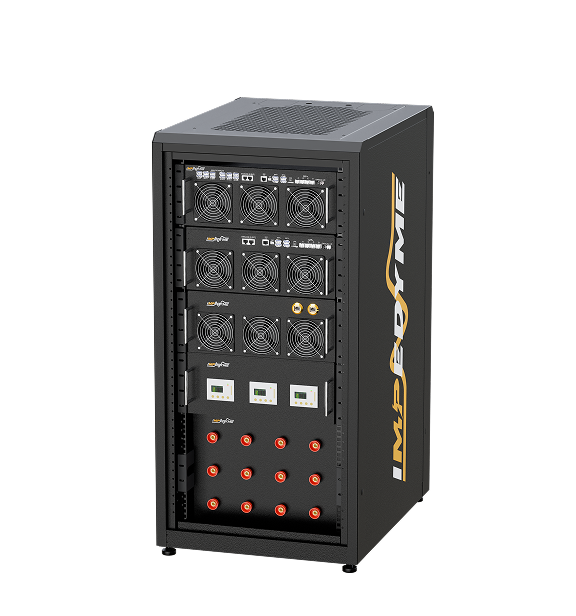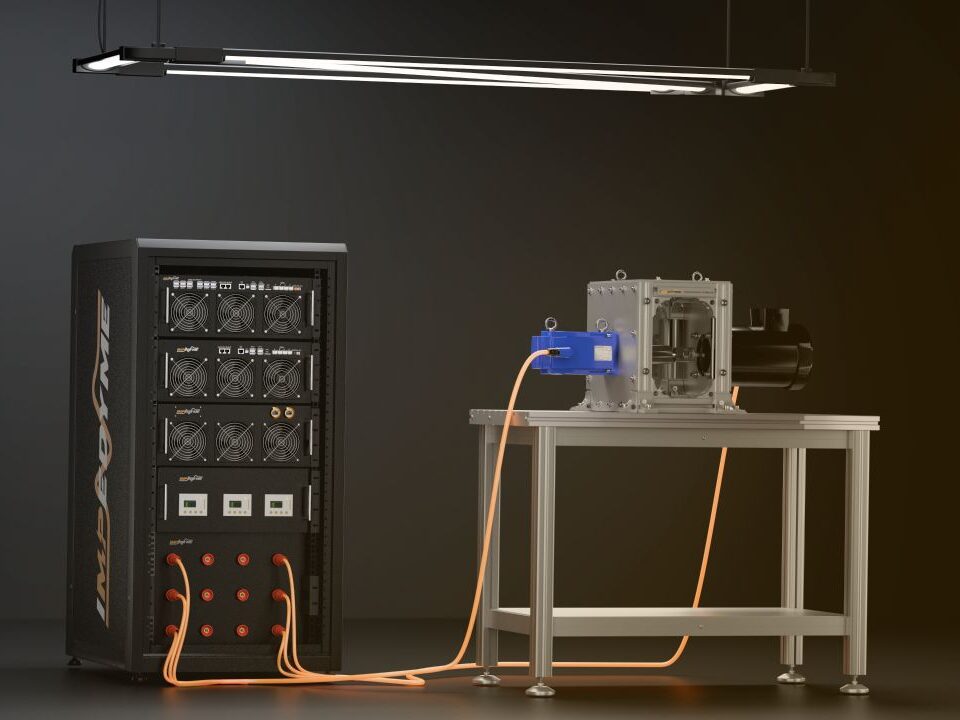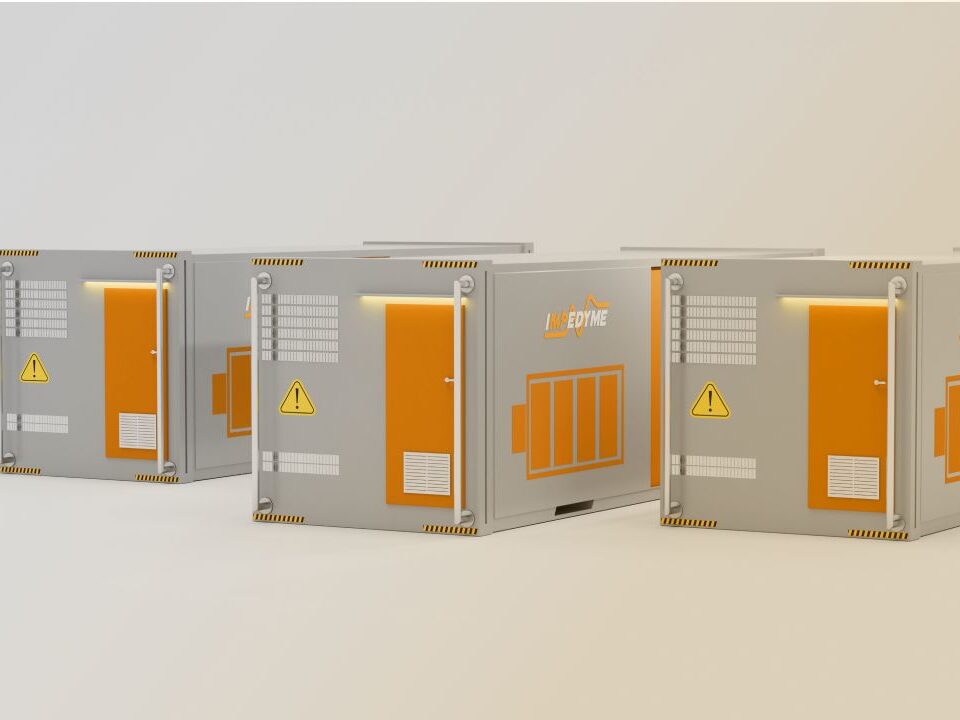
-
 Induction Motor
Induction Motor
-
 Automotive Electrical System Simulation
Automotive Electrical System Simulation
-
 DC/DC Bidirectional Converter
DC/DC Bidirectional Converter
-
 PWM Control for Brushless DC
PWM Control for Brushless DC
-
 BLDC Motor Control and Drive Simulation
BLDC Motor Control and Drive Simulation
-
 Electric Vehicle Fast Charger Simulation
Electric Vehicle Fast Charger Simulation
-
 DFIG Wind Turbine Simulation
DFIG Wind Turbine Simulation
-
 Dual Active Bridge
Dual Active Bridge
-
 EV Dynamometer Test Environment Simulation
EV Dynamometer Test Environment Simulation
-
 Electric Vehicle Simulation
Electric Vehicle Simulation
-
 Three-Phase Grid-Connected Inverter Using Direct-Q…
Three-Phase Grid-Connected Inverter Using Direct-Q…
-
 Three-Phase Grid-Connected Solar Photovoltaic
Three-Phase Grid-Connected Solar Photovoltaic
-
 Grid-Connected Rectifier
Grid-Connected Rectifier
-
 Grid-Tied Inverter System
Grid-Tied Inverter System
-
 Torque Control in a Hybrid Excitation Synchronous …
Torque Control in a Hybrid Excitation Synchronous …
-
 Wye-Delta Starting Circuit
Wye-Delta Starting Circuit
-
 IPMSM-Based Axle-Drive
IPMSM-Based Axle-Drive
-
 Simplified Parallel Hybrid Electric Vehicle
Simplified Parallel Hybrid Electric Vehicle
-
 Simplified Series Hybrid Electric Vehicle
Simplified Series Hybrid Electric Vehicle
-
 Series-Parallel Hybrid Electric Vehicle
Series-Parallel Hybrid Electric Vehicle
-
 Three-Phase Matrix Converter Simulation
Three-Phase Matrix Converter Simulation
-
 Venturini Modulation for Three-Phase Matrix Conver…
Venturini Modulation for Three-Phase Matrix Conver…
-
 Microgrid Frequency Regulation Using Vehicle-to-Gr…
Microgrid Frequency Regulation Using Vehicle-to-Gr…
-
 Three-Phase Modular Multilevel Converter
Three-Phase Modular Multilevel Converter
-
 Field-Oriented Control
Field-Oriented Control
-
 Interior Permanent Magnet Synchronous Generator
Interior Permanent Magnet Synchronous Generator
-
 Permanent Magnet Synchronous Machine
Permanent Magnet Synchronous Machine
-
 PMSM Rotor Angular Velocity
PMSM Rotor Angular Velocity
-
 PMSM-Based Electrical Traction Drive
PMSM-Based Electrical Traction Drive
-
 Maximum Power Point Tracking
Maximum Power Point Tracking
-
 Six-Phase Permanent Magnet Synchronous Machine
Six-Phase Permanent Magnet Synchronous Machine
-
 Synchronous Machine-Based Electrical Drive Simulat…
Synchronous Machine-Based Electrical Drive Simulat…
-
 Single-Stage Solar Inverter
Single-Stage Solar Inverter
-
 Three-Phase Cycloconverter Simulation
Three-Phase Cycloconverter Simulation
-
 Totem-Pole PFC Simulation
Totem-Pole PFC Simulation
-
 Twelve-Pulse Thyristor Rectifier
Twelve-Pulse Thyristor Rectifier
-
 Two-Wheeler On-Board Charger
Two-Wheeler On-Board Charger
-
 Vienna Rectifier Simulation
Vienna Rectifier Simulation
-
 High-Voltage Direct Current
High-Voltage Direct Current
-
 Wireless Power Transfer
Wireless Power Transfer

Comprehensive Documentation for Single-Stage Solar Inverter Efficiency Analysis
Table of Contents
- 1 Comprehensive Documentation for Single-Stage Solar Inverter Efficiency Analysis
- 1.1 Introduction
- 1.2 System Overview
- 1.2.1 What is a Single-Stage Solar Inverter?
- 1.2.2 Purpose of the Efficiency Analysis
- 1.3 Key Features
- 1.3.1 Direct DC-to-AC Conversion
- 1.3.2 Power Loss Analysis
- 1.3.3 Modulation Strategy Optimization
- 1.3.4 Load and Environmental Impact Assessment
- 1.3.5 Grid Compliance and Power Quality
- 1.4 Simulation Objectives
- 1.5 Technical Description
- 1.5.1 System Configuration
- 1.5.2 Control Methodology
- 1.6 Advantages of Single-Stage Solar Inverters
- 1.7 Applications
- 1.7.1 Residential Solar Power Systems
- 1.7.2 Commercial and Industrial Solar Installations
- 1.7.3 Utility-Scale Solar Power Plants
- 1.7.4 Microgrids and Distributed Generation
- 1.7.5 Electric Vehicle (EV) Charging Infrastructure
- 1.7.6 Telecommunications
- 1.7.7 Agricultural Applications
- 1.7.8 Water and Wastewater Treatment
- 1.7.9 Research and Development
- 1.7.10 Education and Training
- 1.8 Simulation Benefits
- 1.9 Summary
- 1.10 Future Enhancements
- 1.10.1 Induction Motor
- 1.10.2 Automotive Electrical System Simulation
- 1.10.3 DC/DC Bidirectional Converter
- 1.10.4 PWM Control for Brushless DC
Introduction
Solar inverters play a crucial role in converting DC power from photovoltaic (PV) panels into AC power for grid integration. This model evaluates the efficiency of a single-stage solar inverter, considering power conversion losses and system performance

System Overview
What is a Single-Stage Solar Inverter?
A single-stage solar inverter directly converts DC power from PV panels into AC power without an intermediate DC-DC conversion stage, offering:
✔ Higher efficiency due to reduced power conversion steps.
✔ Lower component count, minimizing cost and complexity.
✔ Faster dynamic response for grid stability.
✔ Compact design suitable for residential and commercial PV systems.
Purpose of the Efficiency Analysis
This analysis focuses on:
✔ Identifying key sources of power losses in a single-stage inverter.
✔ Evaluating the impact of modulation techniques on efficiency.
✔ Optimizing control strategies for maximum energy conversion.
✔ Comparing efficiency under varying load and environmental conditions.
Key Features
Direct DC-to-AC Conversion
✔ Eliminates the need for an intermediate DC-DC conversion stage.
✔ Uses pulse width modulation (PWM) for effective power conversion.
✔ Reduces switching and conduction losses.
➡️ Benefit: Enhances overall inverter efficiency and reliability.
Power Loss Analysis
✔ Considers switching losses in power transistors (IGBTs/MOSFETs).
✔ Evaluates conduction losses in semiconductor components.
✔ Includes thermal losses and their effect on inverter performance.
➡️ Benefit: Identifies critical areas for efficiency improvement.
Modulation Strategy Optimization
✔ Compares sinusoidal PWM (SPWM) and space vector PWM (SVPWM).
✔ Analyzes total harmonic distortion (THD) and its impact on inverter performance.
✔ Adjusts switching frequency to balance efficiency and output quality.
➡️ Benefit: Improves power quality while minimizing losses.
Load and Environmental Impact Assessment
✔ Examines inverter efficiency at different load levels.
✔ Analyzes temperature variations and their effect on component performance.
✔ Evaluates MPPT effectiveness in maintaining optimal power conversion.
➡️ Benefit: Ensures robust performance across diverse operating conditions.
Grid Compliance and Power Quality
✔ Ensures voltage and frequency synchronization with the grid.
✔ Limits harmonic distortion to meet IEEE and IEC grid standards.
✔ Implements reactive power compensation for stable operation.
➡️ Benefit: Enhances grid stability and compliance with regulatory requirements.
- Simplified Design
Single-stage inverters have fewer components compared to multi-stage inverters, reducing complexity and cost.
- High Efficiency
These inverters offer high efficiency in energy conversion, reducing energy losses and improving overall system performance.
- Cost-Effective
The simplified design and reduced component count make single-stage inverters a cost-effective solution for solar power systems.
- Compact Size
Single-stage inverters are typically more compact, making them suitable for space-constrained applications.
Simulation Objectives
This simulation aims to:
✔ Quantify the efficiency of a single-stage solar inverter under real-world conditions.
✔ Identify and minimize key power losses.
✔ Optimize modulation techniques for improved performance.
✔ Evaluate inverter response to dynamic load variations.
Technical Description
System Configuration
- Input: DC power from a PV panel array.
- Power Conversion: Single-stage inverter with direct DC-AC conversion.
- Control Strategy: MPPT algorithm integrated with inverter control.
- Output: AC power for grid connection or standalone applications.
Control Methodology
✔ MPPT-Based Power Regulation: Ensures maximum energy extraction from PV panels.
✔ SPWM/SVPWM Implementation: Optimizes switching patterns for high efficiency.
✔ Power Loss Calculation: Evaluates switching, conduction, and thermal losses.
✔ Dynamic Load Testing: Analyzes inverter response under variable loads.
Advantages of Single-Stage Solar Inverters
✔ Higher efficiency due to reduced conversion stages.
✔ Lower cost and complexity compared to multi-stage inverters.
✔ Faster response time for grid integration and stability.
✔ Compact and lightweight design for easy installation.
Applications
Residential Solar Power Systems
- Home Energy Systems: Single-stage inverters are used in residential solar PV systems to convert DC power from solar panels into AC power for household use. Efficiency analysis helps optimize energy conversion and reduce energy losses.
- Off-Grid Homes: In remote areas without grid access, single-stage inverters provide reliable power for off-grid homes, ensuring efficient energy conversion and storage.
Commercial and Industrial Solar Installations
- Rooftop Solar Systems: Single-stage inverters are used in commercial and industrial buildings to optimize energy generation and grid integration, reducing energy costs and improving sustainability.
- Load Management: Efficiency analysis helps businesses manage energy loads more effectively, reducing peak demand charges and improving energy efficiency.
Utility-Scale Solar Power Plants
- Grid Integration: Single-stage inverters are used in large-scale solar farms to convert DC power from solar panels into AC power for grid integration. Efficiency analysis ensures stable and efficient operation.
- Energy Storage: These inverters are integrated with battery storage systems to store excess energy for use during periods of high demand or low sunlight, improving grid stability and reliability.
Microgrids and Distributed Generation
- Islanded Microgrids: Single-stage inverters are used in islanded microgrids to provide reliable power in remote areas, ensuring efficient energy conversion and continuous energy supply.
- Grid-Connected Microgrids: These inverters optimize energy generation and storage in grid-connected microgrids, enabling seamless transition between grid-connected and islanded modes.
Electric Vehicle (EV) Charging Infrastructure
- Solar-Powered Charging Stations: Single-stage inverters are used in solar-powered EV charging stations to optimize energy generation and storage, ensuring efficient and reliable operation.
- Bidirectional Charging: These inverters enable bidirectional charging, allowing EVs to feed power back into the grid or home during peak demand periods.
Telecommunications
- Base Station Power Systems: Single-stage inverters are used in telecom base stations to ensure stable power supply, optimizing performance and energy efficiency.
- Backup Power Systems: These inverters provide reliable backup power during grid outages, ensuring continuous operation of critical telecom infrastructure.
Agricultural Applications
- Solar-Powered Irrigation: Single-stage inverters are used in solar-powered irrigation systems to optimize energy generation and storage, providing a sustainable and cost-effective energy solution.
- Rural Electrification: These inverters provide reliable power for agricultural operations and rural communities, improving access to electricity in remote areas.
Water and Wastewater Treatment
- Solar-Powered Water Pumping: Single-stage inverters are used in solar-powered water pumping systems to optimize energy generation and storage, ensuring efficient and reliable operation.
- Desalination Plants: These inverters provide a sustainable energy source for desalination plants, supporting water supply in arid regions.
Research and Development
- Prototype Testing: Simulations are used to test and validate single-stage inverter prototypes, reducing the need for physical testing and accelerating development.
- Control Strategy Development: Simulations help develop and optimize control algorithms for single-stage inverters, ensuring efficient and reliable operation.
- Fault Analysis: Simulations help study the behavior of single-stage inverters under fault conditions, improving system reliability and safety.
Education and Training
- Academic Research: Simulations are used in academic research to study the performance and optimization of single-stage inverters.
- Professional Training: Simulations are used in training programs for engineers and technicians, providing hands-on experience with these systems.
Simulation Benefits
By utilizing this simulation, engineers can:
✔ Optimize single-stage inverter design for maximum efficiency.
✔ Identify power loss sources and implement corrective measures.
✔ Ensure compliance with grid standards and power quality regulations.
✔ Improve inverter durability and operational reliability.
Summary
This project provides an in-depth analysis of a single-stage solar inverter’s efficiency, focusing on power loss reduction, control optimization, and grid compliance. By integrating advanced modulation strategies and loss estimation techniques, this system enhances PV energy conversion and utilization.
| Development Stage | Impedyme’s Contribution |
|---|---|
| Control Design | RCP using HIL for rapid algorithm validation |
| Control Hardware Testing | CIL with real-time cycloconverter models |
| Power Stage Verification | PHIL with real voltage and power interaction |
| Final Validation | Full-system PHIL under realistic grid and load conditions |
Future Enhancements
✔ Implementation of AI-based MPPT for adaptive power tracking.
✔ Integration of GaN or SiC-based power switches for reduced losses.
✔ Development of hybrid inverter systems combining battery storage.
✔ Advanced fault detection and self-healing mechanisms.
The efficiency analysis of single-stage solar inverters plays a crucial role in improving solar energy utilization. By optimizing power conversion techniques and reducing losses, this project contributes to the development of more reliable and high-performance solar inverter systems.






